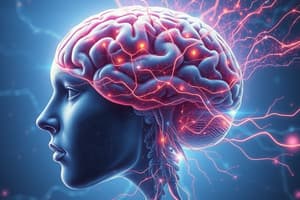Podcast
Questions and Answers
What are the two systems used for control and coordination in animals?
What are the two systems used for control and coordination in animals?
Nervous system and muscular system
What triggers the release of chemicals at the end of an axon?
What triggers the release of chemicals at the end of an axon?
- Chemical reactions
- Touch stimuli
- Electrical impulses (correct)
- Muscle contractions
Where are gustatory receptors located?
Where are gustatory receptors located?
- Inner ear
- Tongue (correct)
- Nose
- Eyes
Movement in response to environmental changes is uncoordinated.
Movement in response to environmental changes is uncoordinated.
The _____ detects changes in the environment.
The _____ detects changes in the environment.
What happens when you touch a hot object?
What happens when you touch a hot object?
How do gustatory receptors affect taste perception?
How do gustatory receptors affect taste perception?
What type of tissues provide control and coordination in animals?
What type of tissues provide control and coordination in animals?
Movement in organisms is always a result of growth.
Movement in organisms is always a result of growth.
What do receptors in our sense organs detect?
What do receptors in our sense organs detect?
The impulse travels from the dendrite to the cell body and then along the ______ to its end.
The impulse travels from the dendrite to the cell body and then along the ______ to its end.
What happens at the end of the axon when an electrical impulse arrives?
What happens at the end of the axon when an electrical impulse arrives?
How does blocking your nose affect your ability to taste food?
How does blocking your nose affect your ability to taste food?
Flashcards are hidden until you start studying
Study Notes
Overview of Control and Coordination
- Movement is often linked to the concept of life, with examples such as seedling growth and animal motion.
- Distinction between movement due to growth (e.g., plants) and movement not related to growth (e.g., animals).
- Responses to environmental changes, like a cat chasing a mouse or children playing, illustrate adaptive movement in living organisms.
- Various stimulus responses lead to controlled movements based on the environment, such as whispering in class rather than shouting.
Importance of Control Systems
- Controlled movement requires recognition of events, followed by specific responses.
- Living organisms use systems of control and coordination for movement.
Nervous System in Animals
- In animals, nervous and muscular tissues facilitate control and coordination.
- Specialized nerve cell tips (receptors) are located in sense organs (e.g., inner ear, nose, tongue) to detect environmental stimuli.
- Gustatory receptors identify taste; olfactory receptors detect smell.
Neurological Function
- Detection of stimuli initiates a chemical reaction that generates an electrical impulse within nerve cells.
- The impulse travels from the dendritic tip to the cell body, then along the axon to the axon terminal.
- At the end of the axon, chemicals are released across the synapse to stimulate adjacent neurons.
- Nervous tissue consists of a network of neurons that conduct information as electrical impulses throughout the body.
Structure of Neurons
- Neurons have specific parts:
- Dendrites acquire information.
- Information travels as electrical impulses through the axon.
- Impulses convert into chemical signals at synapses for transmission to other cells (muscle or gland cells).
Practical Activity Examples
- Tasting sugar with and without a blocked nose demonstrates the influence of olfactory receptors on flavor perception.
- Experience shows that smell significantly affects taste, indicating the interconnectedness of sensory perception.
Overview of Control and Coordination
- Movement is often linked to the concept of life, with examples such as seedling growth and animal motion.
- Distinction between movement due to growth (e.g., plants) and movement not related to growth (e.g., animals).
- Responses to environmental changes, like a cat chasing a mouse or children playing, illustrate adaptive movement in living organisms.
- Various stimulus responses lead to controlled movements based on the environment, such as whispering in class rather than shouting.
Importance of Control Systems
- Controlled movement requires recognition of events, followed by specific responses.
- Living organisms use systems of control and coordination for movement.
Nervous System in Animals
- In animals, nervous and muscular tissues facilitate control and coordination.
- Specialized nerve cell tips (receptors) are located in sense organs (e.g., inner ear, nose, tongue) to detect environmental stimuli.
- Gustatory receptors identify taste; olfactory receptors detect smell.
Neurological Function
- Detection of stimuli initiates a chemical reaction that generates an electrical impulse within nerve cells.
- The impulse travels from the dendritic tip to the cell body, then along the axon to the axon terminal.
- At the end of the axon, chemicals are released across the synapse to stimulate adjacent neurons.
- Nervous tissue consists of a network of neurons that conduct information as electrical impulses throughout the body.
Structure of Neurons
- Neurons have specific parts:
- Dendrites acquire information.
- Information travels as electrical impulses through the axon.
- Impulses convert into chemical signals at synapses for transmission to other cells (muscle or gland cells).
Practical Activity Examples
- Tasting sugar with and without a blocked nose demonstrates the influence of olfactory receptors on flavor perception.
- Experience shows that smell significantly affects taste, indicating the interconnectedness of sensory perception.
Studying That Suits You
Use AI to generate personalized quizzes and flashcards to suit your learning preferences.




